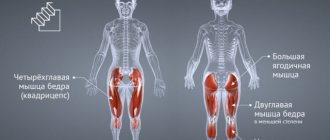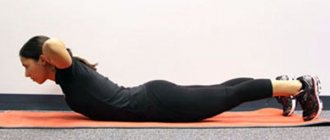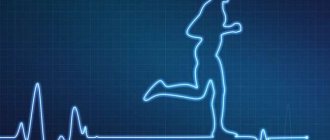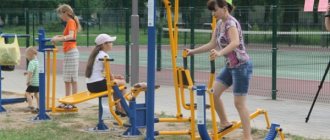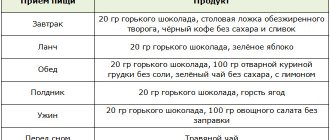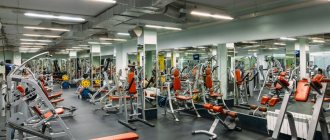Let's talk about the stepper - a popular exercise machine that you have probably seen in training rooms. We will take a detailed look at what a stepper is - what muscles work during exercise, what benefits this device brings to health, what types of stepping machines exist, and how to properly exercise on a stepper.
Modern people walk much less than even in the last century. Having your own car, sedentary work in the office or at home, preferring passive over active rest - all these factors do not contribute to slim legs and buttocks. It is not surprising that there are more and more people with excess weight, and girls have to fight for a slim figure with all possible means.
The load on the musculoskeletal system in modern people is minimal: this is reflected in both the figure and well-being. Osteochondrosis, arthrosis of the knees and hips have become commonplace in the prime of life. Not everyone has the time to regularly visit the gym and beauty salons. In this situation, the most expedient and effective way to solve the problem would be to purchase a home exercise machine.
Stepper simulator - general information
First, let's figure out what a stepper is. This device is a cardio machine that simulates climbing stairs. The name comes from the English “step”, that is, “step”. Like other cardio equipment, this equipment provides a person with the necessary volume of movements that are natural to him. Stepper exercises are aimed primarily at strengthening the muscles of the legs, thighs and buttocks.
Most people who purchase this exercise machine practice exercises on a stepper for weight loss and figure correction. In fact, the benefits of the stepper are more multifaceted than eliminating extra pounds:
- the exercise machine strengthens the heart and blood vessels,
- stimulates and develops the respiratory system,
- makes the back and abdominal muscles work.
The main advantage of the stepper is its ease of operation. In addition, the device does not take up much space and is relatively inexpensive. For home use, mini-steppers are usually chosen: compact and functional devices from the world's leading manufacturers of sports equipment. Today, you can easily choose and buy a stepper for your home in an online store or a regular sporting goods store.
How is a stepper useful?
Why do you need a stepper anyway? This leg exerciser is designed to increase a person's physical activity and simulates the movements of climbing stairs. The name of the simulator indicates this: in English “step” is translated as “step”. It is known that walking at a moderate pace burns excess fat very well without overloading the joints. Working out on a cardio machine will help you simulate walking down the street and burn off extra calories. What muscles does the stepper train, besides the leg muscles? The cardio machine mainly works the muscles of the thighs and buttocks, tightening them and making them more elastic.
It is used in many gyms and is recommended for weight loss. The benefits of cardio equipment for weight loss are truly great, but it is used not only to combat obesity. The stepper improves health, develops many muscle groups and improves joint health.
Types of steppers
There are several types of steppers. Based on size, these simulators are classified into two types:
- Regular steppers;
- Mini steppers.
The first option is a rather large design: such a simulator is equipped with handrails that help maintain balance, or levers that provide additional stress on the muscles of the arms and back.
Mini steppers are a simple platform with pedals. Some modifications are also equipped with additional devices. A stepper with expanders allows you to load your arms and back while walking. This is the most effective machine for cardio training at home.
Based on the type of movement, devices are divided into:
- Classic;
- Balancing;
- Rotary.
The classic simulator simulates climbing stairs as accurately as possible (in anatomical and physiological terms).
The balancing apparatus, as the name suggests, helps further develop coordination and strengthen the abdominal muscles. When moving, such a platform shifts the center of gravity of the body in different directions. At first, the movements may seem difficult, but after gaining the dexterity, you can supplement walking with various movements of the arms and legs, giving additional load. This model is often called the “rock and roll stepper”: the exercises really resemble the familiar energetic dance.
The rotary stepper simultaneously loads the back, since when walking you need to turn your body. Exercises on such equipment are characterized by increased intensity: after literally 10 minutes of exercise, a person receives a load on all the muscles of the body and especially on the “breeches zone”, a problem for many women.
According to the nature of their performance, steppers are divided into:
- Professional – used in the halls and are characterized by increased resistance to wear (these models can work almost around the clock);
- Autonomous - run on batteries or built-in generators;
- Folding - do not take up much space, but are less durable and are not designed for intensive training.
Steppers are also divided into mechanical and electromagnetic. The first type operates hydraulically. The trainee presses on the pedal, the cylinder compresses, and when the weight is transferred to another pedal, it unclenches. These models do not make noise during operation and do not require an external power source.
Electromagnetic devices operate due to the magnetic resistance of the pedals. The load can be adjusted via the control console. Modern models are equipped with many functions, have built-in training programs or allow you to create an individual training plan. At the same time, various vital signs are read using sensors placed on the body:
- Pulse rate;
- Number of steps taken;
- Movement speed;
- Number of calories burned.
Such exercise machines are rarely used at home and are more suitable for gyms and fitness centers.
Stepper - advantages of classes
The stepper helps strengthen the walls of blood vessels and heart muscles ; Improves the human respiratory system ; The benefit of the stepper also lies in the fact that while working on the simulator, not only the muscles of the buttocks and thighs work, but also the abdominal and back muscles .
An important advantage of the stepper is its extremely simple operation , which does not require special skills or training. It is quite compact, so it will not take up much space in your home. Depending on where exactly this simulator will be located, they acquire a certain type of it, because for all their simplicity of the device, they have some design and dimensional differences. Depending on individual preferences, you can choose a stepper and see which muscles work most actively.
Benefits of a stepper
The therapeutic and aesthetic effects of the stepper are numerous and varied:
- Weight stabilization by burning fat deposits;
- Strengthening the muscles of the legs and buttocks;
- Back and abs training;
- Figure correction;
- Training of the heart muscle and blood vessels;
- Stimulation of the respiratory system;
- Development of coordination;
- Stimulation of metabolic processes;
- Strengthening the immune system.
Regular training on a stepper is useful for everyone who cares about the slimness of their body and the full physiological load of the musculoskeletal system. As a therapeutic agent, the device is recommended for people at the rehabilitation stage after the main course of treatment for injuries and degenerative diseases of the limbs and spine.
Comparison with other cardio machines
The fitness industry offers athletes a variety of leg exercise equipment. Let's look at the main differences between steppers and other popular devices.
Treadmill
The machine is designed to warm up before the main part of the training, strengthen the cardiovascular system and reduce body fat.
The advantage over a stepper is that it consumes more calories in the same period of time. This is due to the intense work of the whole body when running.
The electronic track has a number of disadvantages: increased noise, large size and shock load on the knee joints and spine.
The stepper takes up little space, is practically silent and does not injure the musculoskeletal system.
Exercise bike
The device simulates the pedaling of a bicycle. Designed for cardio exercise, burning subcutaneous fat, and strengthening the lower body.
The advantages include high-quality training of the thighs and legs, as well as increased calorie consumption.
The disadvantages are the lack of stress on the upper body.
A stepper differs from a bicycle machine in that it trains the muscles of the legs and buttocks, develops stabilizers, and also strengthens the arms and shoulders by incorporating rubber expanders into the work.
Orbitrack or elliptical trainer
The simulator looks like a Nordic walking stepper. The difference is that its pedals do not move up and down, but along an elliptical path.
The range of movement of an athlete on an orbit track is much wider than on a stepper. This allows you to simultaneously use a large number of muscles and thereby increase calorie expenditure.
The disadvantages of the ellipsoid are its rather high cost and large size.
A simple stepper, as a home exercise machine, is more preferable because it takes up less space, is affordable, and is effective in losing weight and strengthening the lower extremities.
How to train on a simulator with maximum efficiency
The main condition for successful training is consistency of practice. It is advisable to train three times a week. Walking on a stepper should not be too intense - especially in the first months of training: avoid overload and muscle strain.
Be sure to monitor your heart rate (first, determine your heart rate and calculate your exercise rate). The rule of thumb for determining the acceptable threshold is 200 beats minus age. If the number of heart beats begins to exceed the permissible values, rest and restore your breathing. The frequency of inhalation and exhalation is an indicative criterion for the intensity of exercise. If you feel difficulty breathing, it means you are overloading your body: increase the load consistently. It would not be superfluous to consult a therapist before purchasing a simulator or starting classes.
Another indispensable condition for achieving maximum benefits from training is methodicality. Perform the movements correctly, at an average rhythm, without excessive tension.
There are several movement options that are suitable for both beginners and people with experience:
- Standard step: keep your body straight and walk as if climbing stairs. You can increase or decrease the pace by changing the pressure of your foot on the pedals.
- Half-foot step ("half-foot"): straight body, quick and small steps with emphasis on the forefoot.
- Heavy step: the body leans slightly forward, the foot is fully supported, the pressure is slow, with noticeable effort.
The first workouts should be short: no more than 10 minutes. three times a week. Gradually, the duration of classes can be increased to 30 minutes. in a day.
General rules for practicing on a stepper:
- Be sure to warm up (5-10 minutes);
- Exercise in comfortable shoes that provide reliable grip on the surface of the platform:
- Train in clothes made from natural fabric;
- During the first lessons, you should not move without support - hold on to the handrails and watch your balance;
- Beginners should place their foot fully on the pedal to avoid overloading the ankle joint;
- Choose the optimal range of movements: do not bend your legs too much and straighten them at the knee joint to the end;
- To lose weight, choose a regimen with a high cadence and low resistance.
Check the functionality of the simulator before use. Make sure that all components of the device are present and securely fastened. If you find it boring and uncomfortable to exercise in silence, you should choose specific music for training. Ideally, the rhythm of the musical accompaniment will coincide with the rhythm of your steps.
How many calories are spent on a stepper?
Exercising on a stepper burns a lot of calories, which in turn leads to the burning of excess fat reserves. If you exercise intensively, you can burn as much as 500 kcal in an hour! The amount of energy expended may vary depending on weight, fitness level, metabolic rate, and workout intensity. By practicing it for an hour a day, you will successfully lose weight or maintain weight by slightly increasing the caloric content of your diet. A stepper is an aerobic exercise machine that is aimed not at increasing muscle mass, but at burning subcutaneous fat. It also strengthens the heart muscle and blood vessels, and trains the lungs. A moderate intensity workout will allow you to burn 200-250 kcal in half an hour.
Important! Loads should be increased gradually. You shouldn’t work out for an hour on the first day of training - you won’t want to work out the next day due to overexertion. The ideal training regimen is 3 times a week. Between workouts there should be 1-2 days of rest so that the muscles have time to recover.
If there is no rest, the results from training will be much worse. In addition, such a shake-up is harmful to the body and health. The results from working out on a stepper depend on the degree of your effort. If you practice with the lightweight version, then do not expect quick results. It is best to include some exercises in your stepper training: squats, lunges, crunches and push-ups. You can also alternate exercises on the stepper with other cardio equipment. Train all muscle groups to burn maximum calories. For exercise at home, it is advisable to purchase an arm exercise machine. When losing weight, it is important to remember that exercise alone will not help you lose weight. An integrated approach is important - proper nutrition and sufficient sleep and rest.
Who should not use the stepper (contraindications)
We have already talked about the need for medical consultation (even if you are 20 years old and have no health problems). It’s better to play it safe than to get spinal damage (in the presence of hidden pathologies) or provoke the development of internal diseases.
It is not recommended to conduct training in the following cases:
- For untreated injuries of the limbs and spine (sprains, dislocations, injuries);
- If there are serious diseases of the heart, kidneys, liver;
- During pregnancy (2-3 trimester);
- If you have diabetes mellitus in the stage of decompensation;
- With arterial hypertension of 3 degrees.
You should not exercise if you have a cold, inflammatory or infectious disease with fever. For older people, consultation with a doctor is mandatory.
Contraindications
Before purchasing a stepper, it is advisable to consult a doctor (especially if you have chronic diseases). If your doctor allows you to exercise, then you can happily start exercising.
Video
Contraindications to training on a stepper are quite serious:
- Untreated sprains, dislocations and other similar injuries;
- Diseases of the cardiovascular system, kidneys, liver;
- Pregnancy in the second and third trimester;
- Arterial hypertension of the third degree;
- Acute form of diabetes (decompensated diabetes). For this type of disease, there is no treatment or it does not help.
Important! You should not exercise on the stepper during illness (cold, acute respiratory viral infection), especially at elevated body temperature. Take your time - as soon as you recover and your body gets stronger, you can resume classes. Elderly people should approach stepper training with caution; before starting classes, consultation with a specialist is necessary.
If you are not satisfied with the results of training on a stepper or the exercises bring you discomfort, re-read the instructions for its use. Often the effectiveness of devices depends on how correctly they are used.
Video
How to choose a reliable stepper for your home
To choose a stepper for your home, it is better, of course, to ask a specialist (gym trainer) for advice. A salesperson in a store may offer you not the most comfortable, but the most expensive model. Much depends on your own financial capabilities and (most importantly) the free space in your living space.
If you have purely practical goals (lose weight, remove fat from the thighs and buttocks), then the simplest and most inexpensive modification will do. If you are going to track your training progress and are not limited in funds, purchase the most expensive model with the ability to customize and reconfigure and functions for monitoring vital signs. Such devices will clearly show how many calories are consumed, how many steps are taken, and what is the heart rate.
If you want to get by with the minimum, buy a regular (or rotary) hydraulic simulator. If you don’t have enough space in your apartment, take a mini-stepper or a “rock and roll” model. Such steppers are convenient and functional, but do not allow you to adjust the load. The price range for this equipment is 1,800 - 20,000 rubles.
What is a stepper?
Why do you need a stepper trainer? Speaking a little more generally, a stepper is a step-by-step cardio exercise machine that simulates a person climbing stairs . English connoisseurs know that “step” means “step,” so everything here is logical. This simulator makes up for the lack of load and movements that a person, in principle, should perform every day.
What muscles work on the stepper?
As for the muscles on which it affects, these are, first of all, the muscles of the buttocks and legs, as well as the thighs . Here is the answer to your question regarding what a stepper trains.
The stepper is considered an excellent tool for adjusting your weight, so many people purchase it as a remedy for losing extra pounds. However, the scope of its application is much wider than the banal fight against obesity.
What are the benefits of using a stepper?
Like any cardio machine, the stepper has a beneficial effect on the human body . What does it mean for your training:
Burning extra pounds, which is a consequence of intense exercise. Strengthening an entire muscle group: abs, back, buttocks, thighs, etc. Strengthening the cardiovascular system. Normalization of breathing. Improving human coordination. General strengthening of the body's protective properties and improvement of well-being.
It is quite difficult to overestimate the beneficial effects of this simulator, because regular training on it really brings tangible results to those who are struggling with excess weight. Another important advantage of the stepper is the fact that it not only helps burn calories , but also gives the body a beautiful contour , so it is an effective fitness tool. The stepper simulator will tell you which muscles need training the most.
In addition, the stepper helps to recover from injuries to the bones and spine, which is confirmed by many specialists and doctors.
